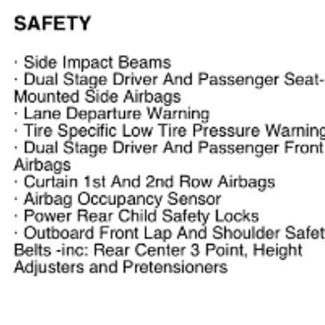Development of Clear Requirements: New Vehicle Function

Development of Clear Requirements:
Introduction – Development of Clear Requirements
In the dynamic landscape of the automotive industry, the genesis of new technologies and features stems from a complex interplay of factors. Government regulations play a pivotal role, often driving innovation through active lobbying efforts to align with emerging technologies. Therefore, the development of Clear Requirements becomes paramount for the new vehicle functions intended for mass production.
Consequently, the mandates go to suppliers to furnish components that comply with these regulations, ensuring the delivery of ostensibly safe products to consumers. However, this raises pertinent ethical questions:
- Is technological advancement primarily aimed at serving public interests or meeting regulatory mandates?
- Are manufacturers solely focused on adhering to government stipulations or genuinely committed to producing essential safety-oriented vehicles?
Such distinctions are crucial in the development cycle, impacting engineering analysis, testing, and verification costs. This multifaceted landscape encompasses three distinct knowledge realms:
- Firstly, the explicit requirements outlined in governmental documents
- Secondly, the array of available “off-the-shelf” technologies from the supply base
- Finally, the curated selection of features for specific vehicle models and release years.
It is the latter that holds the reins of responsibility, empowered to execute designs that address legislative safety concerns while leveraging available technologies for efficient and financially viable vehicle production. As the integrator of technology and assembly, the Vehicle Manufacturer plays a pivotal role in articulating Clear Requirements and sourcing pertinent technologies.
Vehicle Level Feature – Element of Market Strategy
Addressing the Vehicle Marketing Strategy, transparency is the key. Every vehicle on the dealer’s lot proudly displays a sales sticker, showcasing both regulated and innovative features. This serves a dual purpose: meeting government requirements and informing potential buyers of feature availability. It also represents a commitment by the manufacturer to ensure these features function in accordance with regulations. Safety features, such as airbags, seatbelts, and child safety locks, are prominently featured.
Each element of vehicle content is accompanied by disclosures outlining its applicability and functionality in various scenarios. Yet, there exists a significant gap between customer perception and actual performance capabilities, necessitating attention. For instance, while cruise control is a common feature, it’s essential to clarify that it does not equate to autopilot functionality. Addressing such disparities is crucial in fostering consumer trust and satisfaction.
Referencing Land Rover vehicle sales sticker: https://monroneylabels.com/assets/land_rover_preview-820df1fecc6159fe6239cfc4d6b77713d7dba230cf8bedfdd3641253c1e8f275.jpg
Vehicle Level Feature – Seat Belt Example
When perusing the vehicle sticker, prospective buyers often ponder the purpose behind each featured component. Take, for instance, the seat belt assembly. This integral part of the vehicle incurs added costs for the buyer but plays a crucial role in safety. Seat belts are meticulously designed, developed, and integrated into the vehicle to fulfill their primary function: preventing occupants from shifting during travel, thereby enhancing safety and reducing the risk of injury.
So, why are seat belts essential? There are two primary reasons: firstly, governmental regulations mandate their inclusion, and secondly, manufacturers prioritize occupant safety, underscoring their commitment to passenger well-being. Understanding these factors sheds light on the importance of seat belts in vehicle design and underscores their role in safeguarding occupants.
Define the (New) Feature Function - Clear Requirements
Comparing to the physical safety tools, like seatbelts, which are obvious to see and understand, to the more complex sensing and management of the senor related systems and functions are not very straightforward. Therefore, For any Vehicle Level Feature – Clear Requirments:
- There is a need to develop a clear definition of the intended function, which will be addressing the government regulation
- Also encompass all possible applications and conditions intended, as well as not intended, in order to provide an actual “safety” element to the user of the product
In the simplest form of the “Definition: The Vehicle Feature (name) shall be capable of (function) in the following conditions (listed).
Here is Systems Engineering terminology / definition of the mechanical seat belts (passive restraints function) assembled in any vehicle: This Feature (Passive Restraints) is intended to prevent injury for the occupant wearing the seat belt properly during utilization of the vehicle.
The disclosure for the terminology used:
- This Feature – applies to any seat equipped with the seat belt assembly in this vehicle
- Intended to prevent injury – the primary safety function
- Occupant wearing seat belt properly – conditions for the usage of the safety tool by the user
- During utilization of the Vehicle – includes all environmental and any situational circumstances, etc.
- Does not list any limitations. Only mentions the “proper use” by the occupant
The Reasons / Arguments in favor of the Clear Requirements (Definition of Function)
- If the definition is simple and clear, it can be tested. In this case this is a direct reference to the Vehicle level Test Plan, Validation Documentation, all of the Integration activities, including the final assembly processes
- The Vehicle level requirements can be easily rolled down to the Systems participating in the Execution of the design elements, their definitions, interfaces
- From Systems to Subsystems requirements – it help with the SOR documentation for the sourcing of the components from the supply base, as well as helping all of the stakeholders to develop suppliers’ development and validation plans
Referencing Systems Engineering V Model: https://georgedallen.com/systems-v-model-strategy-in-automotive-design/
Conclusion - Clear (Requirements) Definition of the Function
A Clear Definition of Function plays a pivotal role in streamlining vehicle development processes. It facilitates the creation of high-level requirements for vehicle content and enables systematic top-down distribution of requirements through Systems Engineering methodologies.
By addressing both governmental regulations and safety considerations, it ensures that the vehicle’s embodied content aligns with intended functional capabilities. Moreover, this approach emphasizes the comprehensive understanding of total vehicle function across various application conditions, fostering the creation of clear requirements and driving the identification of potential design and process failure modes.
Furthermore, it underscores the need for developing simulation tools to facilitate rigorous verification processes, ultimately leading to the production of safer vehicles. Embracing clear function definition is integral to optimizing vehicle development and enhancing overall safety standards.
Referencing the Systems Engineering Method: https://georgedallen.com/navigating-chaos-systems-engineering-in-vehicle-occupant-sensing/
About George D. Allen Consulting:
George D. Allen Consulting is a pioneering force in driving engineering excellence and innovation within the automotive industry. Led by George D. Allen, a seasoned engineering specialist with an illustrious background in occupant safety and systems development, the company is committed to revolutionizing engineering practices for businesses on the cusp of automotive technology. With a proven track record, tailored solutions, and an unwavering commitment to staying ahead of industry trends, George D. Allen Consulting partners with organizations to create a safer, smarter, and more innovative future. For more information, visit www.GeorgeDAllen.com.
Contact:
Website: www.GeorgeDAllen.com
Email: inquiry@GeorgeDAllen.com
Phone: 248-509-4188
Unlock your engineering potential today. Connect with us for a consultation.


